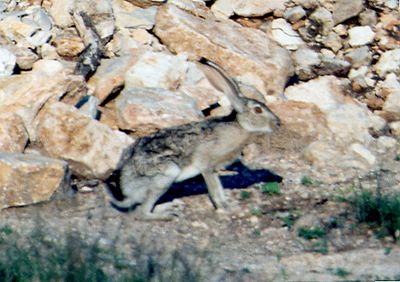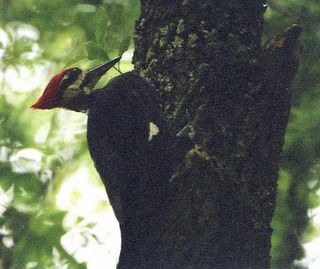Michelle and I just got back from a wonderful weekend in the hill country. We are having a bit of a drought here in the swamp, and it looks like the yard didn't get any rain while we were away. I've been running a sprinkler, which creates little puddles in the driveway. The water attracts quite a few birds, including our resident male Summer Tanager.
We got an early start on the weekend, and arrived in San Antonio on Thursday afternoon. San Antonio has one of the most attractive downtown areas I've ever seen, and I always enjoy going back. We had dinner along the Riverwalk (which incidentally happens to be a good place for Yellow-crowned Night-Herons). Tall bald cypresses shade the paved riverbanks, and there is some impressive tropical vegetation growing beside the paths. As an amateur gardener I suffered pangs of envy when we came upon a flowering hamelia that was taller than we were. Guess we need to use more Miracle Gro...
After dinner we had drinks at Pat O'Brien's, saw the Alamo by moonlight (it might be more accurate to say by floodlight), and wandered through the historic Menger Hotel, looking for ghosts and gawking at all the classy stuff, of which there was an abundance.
Michelle at the Alamo

On Friday we arrived at Neal's Lodge on the Frio River. This would be our base for the rest of the weekend, and I would heartily recommend Neal's to anyone, whether birder or non-birder. Our little cabin was sweeeeeeeeeeeeet. We're talking luxurious. It had a refrigerator, AC, cable TV… after getting settled we had lunch at the cafe overlooking the river, and since it was the middle of the day and too hot for comfortable birding, we decided to go tubing.
Swanky accomodations at Neal's Lodge

From its name, I expected the Frio River to be icy cold. Actually the water was pleasantly cool, perfect for swimming. But tubing on the river turned out to be less relaxing than we anticipated. With the recent lack of rain the river was running low, and the current took us over rocks, resulting in some scrapes and bruises. Some stretches were too shallow, and we had to walk. From the embarcation point it's supposed to be a three-hour trip back to the lodge, but it took us quite a bit longer. I wouldn't characterize it as a grueling ordeal, and I'd do it again, but relaxing it clearly wasn't. Considering how crowded the river was the next day, our decision to go on Friday turned out to be a fortuitous one.
River of No Return; the perilous Frio

Even without binoculars I was able to do some birding as we floated downstream. Yellow-throated Warblers were singing and seemed to be fairly common in the bald cypresses along the river. Twice I saw Green Kingfishers, and toward the end of the trip Michelle and I got close views of a stunning male Vermilion Flycatcher. The water was clear, and in the deeper pools we could see catfish swimming below us. Damselflies were mating, and frequently alighted on us and our tubes.
After a steak dinner and some recovery time, we spent most of Friday evening at the pecan grove near Neal's Lodge. Within this shady grove the lodge maintains feeders, and a faucet provides a constant drip to attract birds, but we had better luck walking along the entrance road. Michelle finally got her elusive Painted Bunting there (afterward we saw many more in other places, which is the way it usually works). We also saw more Vermilion Flycatchers, Blue Grosbeak, Indigo Bunting, Black-tailed Jackrabbit, and some very nervous White-tailed Deer. At sundown we waited in the pecan grove for the Chuck-will's-widows to wake up. Lightning bugs were flashing all around us, and as the dusk deepened a couple of Chuck-will's-widows finally started chirping their names - unfortunately they never came close enough to be viewed. An armadillo ambled out of the grass and came within a yard of where we were standing, then bolted back into the brush. I tried playing taped calls, hoping to lure in an Eastern Screech-Owl, but got no response. Later we had better luck back at the lodge, where I managed to spotlight one not far from our cabin.
Bird geek standing in a juniper thicket

Most of Saturday was spent birding around Neal’s Lodge, but the real highlight was an evening trip to the Frio Bat Cave south of Concan. It’s estimated that about 17 million Mexican Free-tailed Bats inhabit the cave, and at sundown they all leave en masse. We got there well before dark, and had plenty of time to watch the Cave Swallows flying around while we waited for the bat exodus. All at once the bats began to emerge, and it was awesome standing near the mouth of the cavern as the bats swarmed around us. Red-tailed Hawks were waiting nearby, and we watched them repeatedly dive into the mass of bats trying to nab a furry snack. A couple of students were there doing research, catching a few of the bats with big butterfly nets and doing infrared analysis of the ones they caught. Apparently some of these bats travel as much as 40 miles from the cave, and the researchers were interested in how they use and conserve energy during their nightly commutes. We returned to the lodge at dusk, and ended the day with a moonlight swim in the river. The water felt great, and it was nice having the Frio all to ourselves!
Sunday we took a final early-morning walk behind the store at Neal’s Lodge, where we observed Black-bellied Whistling-Ducks on their way to somewhere else, a Greater Roadrunner cooing from a treetop, a couple of singing Bell’s Vireos, a gorgeous male Blue Grosbeak, and a Striped Skunk.
We packed up our stuff, said goodbye to Neal’s Lodge, and drove to Lost Maples State Natural Area, where we hiked the East Trail as far as the ponds. The terrain and vegetation of the Texas hill country often bears a striking resemblance to parts of California (with some obvious differences, like the juniper thickets and bald cypresses along the rivers). The path to the ponds follows a little creek through a rocky wooded canyon that reminded me of Alum Rock Park near San Jose. The two parks also share numerous bird species, and along the trail we saw Black Phoebe, Canyon & Bewick’s Wrens, Lesser Goldfinch, etc. Even the species that differ are somewhat analogous (Acadian Flycatcher instead of Pacific-slope Flycatcher, White-eyed Vireo replacing Hutton’s Vireo). One of the butterflies we saw along the creek appeared to be a California Sister (!), a species that in my mind is always associated with the Santa Cruz Mountains back home. The whole time I was still searching for a couple of elusive hill country specialties – Black-capped Vireo and Golden-cheeked Warbler. Neither was seen on this trip, nor could I turn any of the innumerable Turkey Vultures we saw into a Zone-tailed Hawk. Guess that just gives us a good excuse to go back…
About Michelle, I couldn't have asked for a better companion on a trip like this. She withstood relentless birding, my equally relentless bad jokes, sharp river rocks, and took it all in good cheer. In fact she actually enjoyed the non-stop birding, and seemed genuinely thrilled when we finally got a good look at a roadrunner. This trip again confirmed for me that this is the person I want to spend the rest of my life with. Thanks, Michelle.
Bird list from our trip (16-19 June): Great Blue Heron, Cattle Egret, Yellow-crowned Night-Heron, Black-bellied Whistling-Duck, Black Vulture, Turkey Vulture, Red-shouldered Hawk (heard only), Red-tailed Hawk, White-winged Dove, Mourning Dove, Inca Dove, Common Ground-Dove, Yellow-billed Cuckoo (heard only), Greater Roadrunner, Eastern Screech-Owl, Chuck-will’s-widow (heard only), Black-chinned Hummingbird, Green Kingfisher, Golden-fronted Woodpecker, Ladder-backed Woodpecker, Eastern Wood-Pewee, Acadian Flycatcher, Black Phoebe, Eastern Phoebe, Vermilion Flycatcher, Ash-throated Flycatcher, Western Kingbird, Scissor-tailed Flycatcher, Purple Martin, Cave Swallow, Barn Swallow, Common Raven, Carolina Chickadee, Black-crested Titmouse, Canyon Wren, Carolina Wren, Bewick’s Wren, Blue-gray Gnatcatcher (found a nest containing two baby cowbirds!), Long-billed Thrasher, White-eyed Vireo, Bell’s Vireo, Yellow-throated Vireo, Yellow-throated Warbler, Black-and-white Warbler, Summer Tanager, Northern Cardinal, Blue Grosbeak, Indigo Bunting, Painted Bunting, Olive Sparrow (heard only), Canyon Towhee, Rufous-crowned Sparrow, Chipping Sparrow, Lark Sparrow, Black-throated Sparrow, Red-winged Blackbird, Eastern Meadowlark, Great-tailed Grackle, Bronzed Cowbird, Brown-headed Cowbird, Hooded Oriole, House Finch, Lesser Goldfinch, House Sparrow.
Michelle photographed this jackrabbit or possible chupacabra

Mammals: Rock Squirrel, Fox Squirrel, Black-tailed Jackrabbit, Desert Cottontail, White-tailed Deer, an exotic antelope-type beast that defied identification, Nine-banded Armadillo (2), Striped Skunk, and a few Mexican Free-tailed Bats.





